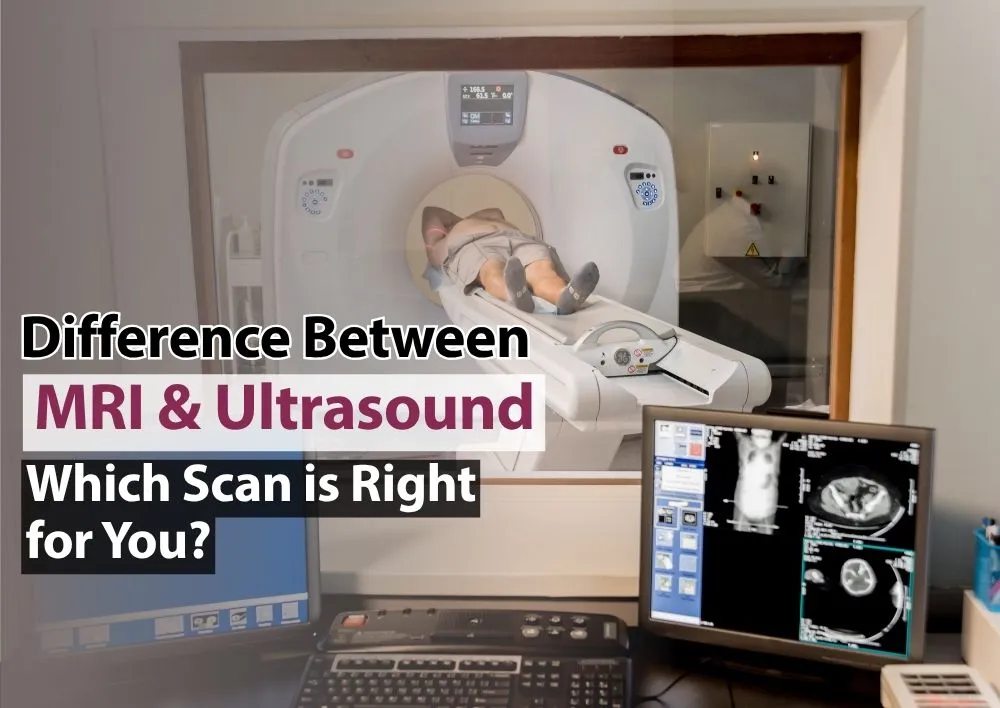Difference Between MRI and Ultrasound: Which Scan is Right for You?
Summary
When it comes to diagnostic imaging, two tests are commonly recommended: an MRI scan (Magnetic Resonance Imaging) and an Ultrasound. Both are non-invasive, safe, and widely used by doctors to diagnose a variety of conditions. However, they are quite different in how they work, the kind of images they produce, and the situations in which they are used. If you have been advised to get a scan and are wondering about the difference between MRI and Ultrasound, this blog post will help you understand in detail.
What is an MRI Scan?
MRI, or Magnetic Resonance Imaging, uses strong magnetic fields and radio waves to create detailed pictures of the body. It is useful for capturing soft tissues, the brain, spinal cord, joints, and internal organs. Unlike X-rays or CT scans, MRI does not use harmful radiation.
An MRI scan usually takes between 20 and 60 minutes. During the procedure, the patient is required to lie still inside a tunnel-like machine. This can sometimes feel uncomfortable for people with claustrophobia, but the images produced are extremely detailed and often necessary for accurate diagnosis.
What is an Ultrasound?
Ultrasound scan, also known as sonography, uses high-frequency sound waves to produce images of the inside of the body. A handheld device called a transducer is moved over the skin, and the sound waves bounce off the organs, creating live images on a screen.
Ultrasound is a fast, painless, and widely accessible test. It is best known for monitoring pregnancy, but it is also used for abdominal scans, thyroid evaluation, blood flow studies, and soft tissue assessments. Since it produces real-time images, it is often used to guide medical procedures like biopsies.
Key Differences Between MRI and USG
Although both tests are safe and effective, they differ in many ways:
-
Technology: MRI relies on powerful magnets and radio waves, while ultrasound uses sound waves.
-
Image Quality: MRI produces highly detailed images, especially of the brain, spine, and joints. Ultrasound provides good images for soft tissues and real-time movement, but is less detailed compared to MRI.
-
Duration: MRI scan usually takes longer (20–60 minutes), whereas ultrasound scans are much quicker (10–30 minutes).
-
Comfort Level: In an MRI, patients need to lie inside a machine, which may cause discomfort. Ultrasound is more comfortable as it is performed on the body surface.
-
Cost: MRI is generally more expensive because of advanced technology, while ultrasound is more affordable.
When is an MRI Recommended?
MRI is typically suggested when doctors need high-resolution images of complex structures. It is used for:
-
Detecting brain tumors, strokes, or neurological disorders.
-
Diagnosing spinal cord injuries, slipped discs, and joint problems.
-
Evaluating ligament or cartilage tears.
-
Studying internal organs like the liver, kidneys, uterus, and heart.
-
Monitoring cancers and their spread.
-
MRI is usually the go-to option when doctors require precise, layered images to make a clear diagnosis.
When is Ultrasound Recommended?
Ultrasound is preferred when doctors need a quick, safe, and real-time look at the body. It is most commonly used for:
-
Pregnancy scans are used to check the growth and health of the baby.
-
Identifying gallstones, kidney stones, or liver conditions.
-
Examining the thyroid, ovaries, or uterus.
-
Blood flow studies using Doppler ultrasound.
-
Guiding procedures such as needle biopsies or draining fluid collections.
-
Its speed, safety, and affordability make it one of the most frequently used imaging tests.
Safety Comparison for MRI and Ultrasound
Both MRI and Ultrasound are considered very safe since they do not use ionizing radiation. However, there are some precautions:
MRI may not be appropriate for patients with pacemakers, certain implants, or metallic clips in their bodies because of the strong magnetic field.
Ultrasound is safe for everyone, including pregnant women and infants, as it only uses harmless sound waves.
Cost Difference for MRI and Ultrasound
Cost is another major factor that distinguishes the two. MRI costs are generally more expensive because they use advanced technology and take longer to perform. Ultrasound prices are relatively cheaper and more widely available, making them a common first choice for doctors when detailed imaging is not required.
MRI vs Ultrasound: Which One Do You Need?
The choice between MRI and Ultrasound depends entirely on your medical condition. If you need detailed imaging of the brain, spine, joints, or internal organs, MRI is usually recommended. But if your doctor needs a quick, safe, and real-time evaluation. For example, during pregnancy or to detect abdominal issues, an ultrasound is the preferred option.
It’s important to remember that only a qualified doctor can decide which scan is best for you. Sometimes, both tests may be used together to provide a more complete picture.
Conclusion:
Both MRI and Ultrasound are safe, effective, and widely used diagnostic tools. MRI provides unmatched detail, while ultrasound offers speed, affordability, and real-time imaging. Understanding the difference between the two helps you feel more confident when your doctor recommends one. If you have been advised to undergo a scan, choose a trusted diagnostic service center near you for accurate results and expert guidance.
Frequently Asked Questions
MRI gives more detailed images, while ultrasound is faster, safer, and more affordable. The choice depends on what needs to be diagnosed.
Yes, ultrasound can capture real-time movement like blood flow or a baby’s heartbeat, which MRI cannot show directly.
Ultrasound is less effective for bones, lungs, and deep tissues compared to MRI or CT scans.
No, ultrasound cannot detect all issues; some conditions require MRI or other imaging for accurate results.
Ultrasound is much cheaper and widely available, while MRI is more expensive because of advanced technology.
MRI is better for detailed imaging of the brain, spine, joints, and internal organs, but ultrasound is better for quick and safe evaluations.
Both MRI and ultrasound are non-invasive, safe, and radiation-free imaging methods used to diagnose health conditions.
MRI is more sensitive for detecting breast cancer, especially in high-risk women, but ultrasound is useful for evaluating lumps and guiding biopsies.
Miracles Mediclinic is among the best centers in Gurgaon for accurate MRI scans with expert care. They use state-of-the-art MRI technology to ensure precise and clear imaging for effective diagnosis. With a team of skilled radiologists and friendly staff, they provide a comfortable and reliable scanning experience for every patient.















Was the information useful?
0 0